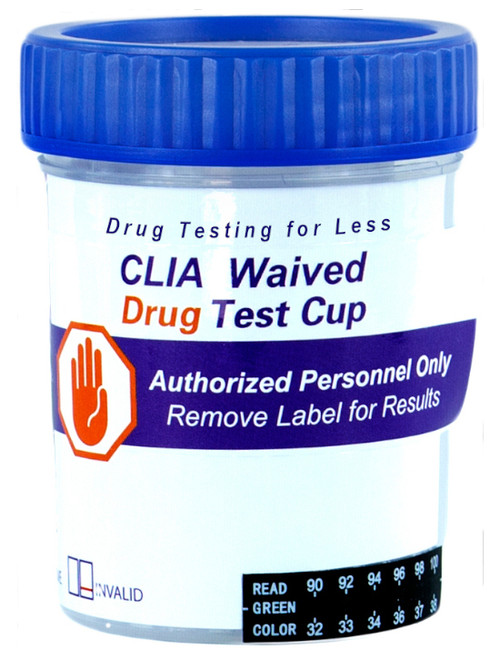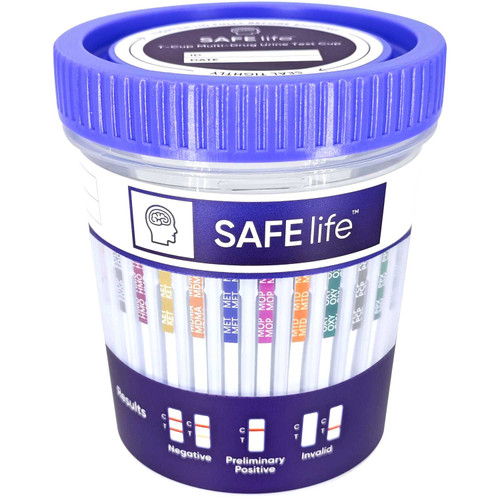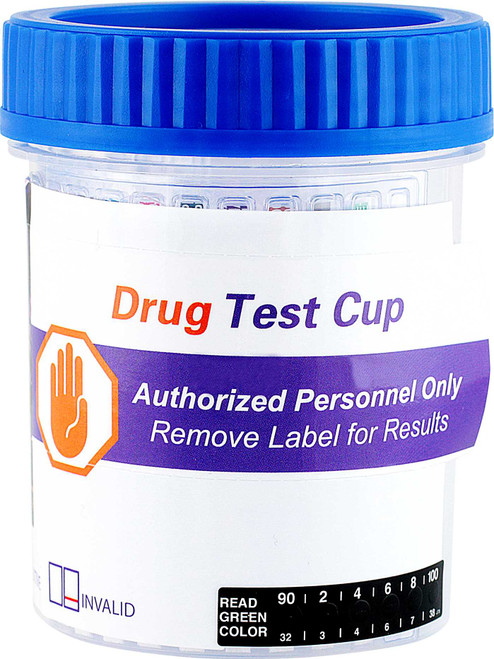Product Description
UrineCheck 7 Adulteration Test Strip, 25/Bottle
Lowest Online Price Guaranteed!
UrineCheck 7 Specimen Validity Adulteration Test Strips provide quick checks for pH, oxidants, and gravity to ensure sample authenticity. The UrineCheck 7 urine adulteration test strip is intended for professional forensic/toxicology use only. It is not intended for use in the diagnosis of disease or illness. This test is a screening test device for the visual qualitative determination of creatinine, nitrite, glutaraldehyde, pH, specific gravity, bleach and pyridinium chlorochromate in urine, it does not indicate the level or concentrations of compounds present in the sample. Results in one minute.
ADULTERANTS TESTED
- Creatinine (CR)
- Nitrite (NI)
- Glutaraldehyde (GL)
- pH Level (PH)
- Bleach (BL)
- Oxidants (OX)
- Pyridinium Chlorochromate (PCC)
SUMMARY AND EXPLANATION
The validity of DAU screening depends on the integrity of the urine samples. Contaminated or adulterated samples may cause erroneous results leading to significant consequences. Hence, it is important to ensure that the samples are intact and consistent with normal human urine.
UrineCheck 7 urine adulteration test strips are plastic strips affixed with seven reagent pads. The pads are chemically treated with specific reagents to provide visual comparison of these pads with the color chart on the container label after dipping the test strip into a urine sample, the following information can be obtained which may be useful in assessing the integrity of the urine sample:
- Whether the sample is diluted or substituted with water or other liquids as indicated by the creatinine and specific gravity tests.
- Whether the sample contains commercially available adulterants including nitrite3 KLEAR, glutaraldehyde, bleach, pyridinium chlorochromate Insta Clean ADD-IT-IVE, LUCKY LAB, and other oxidizing agents STEALTH, Urine Luck.
- Whether the sample is contaminated with common household items, such vinegar, Drano, Hydrogen Peroxide and Bleach as indicated by the pH, Bleach and Pyridinium Chlorochromate tests.
DOWNLOAD REFERENCE DOCUMENTS
![]() UrineCheck 7 Adulterant Test Strips Package Insert
UrineCheck 7 Adulterant Test Strips Package Insert
| ADULTERANTS TESTED | |
| Creatinine (CR) | Testing for sample dilution. In this assay, creatinine reacts with a creatinine indicator in an alkaline condition to form a purplish-brown color complex. The concentration of creatinine is directly proportional to the color intensity of the test pad. In this assay, creatinine reacts with a creatinine indicator in an alkaline medium to form a purple-brown color complex. The color intensity of the test pad is directly proportional to the concentration of creatinine in the sample. Daily creatinine excretion, related to muscle mass of the human body, is usually constant. Urine specimens with creatinine levels of less than 20 mg/dl are indications of adulteration. This test covers the most common form of specimen tampering, specimen dilution. Dilution using diuretics is also often referred to as flushing. |
| Glutaraldehyde (GL) | Testing for the presence of exogenous aldehyde. In this assay, the aldehyde group on the glutaraldehyde reacts with an indicator to form a pink/purple color complex. This analysis is based on the reaction of the aldehyde group on the glutaraldehyde with an indicator to generate a brown color complex. Glutaraldehyde is not a natural component of human urine and it should not be present in normal urine. Common occurrences are the additives of such products such as Clear Choice or UrinAid. |
| Nitrite (NI) | Testing for the presence of exogenous nitrite. Nitrite reacts with an aromatic amine to form a diazonium compound in an acid medium. The diazonium compound in turn couples with an indicator to produce a pink-red/purple color. This test is based on the reaction of aromatic amine to yield a diazonium salt, which then couples with an indicator to form a color complex ranging from pink to dark red depending on the concentration of nitrite in the sample. Nitrate level above 7.5 mg/dl in human urine is considered abnormal. Common occurrences are the additive of such products as Klear. |
| Pyridinium Chlorochromate (PCC) | Testing for the presence of chromate in urine. In this test, the presence of chromate forms a blue-green color complex. |
| Bleach (BL) | Testing for the presence of bleach in urine. In this test, the presence of bleach forms a blue-green color complex. |
| Oxidants (OX) | Testing for presence of oxidizing reagents. In this reaction, a color indicator reacts with oxidants such as hydrogen peroxide, ferricyanide, persulfate, or pyridinium chlorochromateto form a blue color complex. Other colors may indicate the presence of other oxidants. |
| pH Level (PH) | Testing for the presence of acidic or alkaline adulterants. This test is based on the well-known double pH indicator method that gives distinguishable colors over wide pH range. The colors range from orange (low pH) to yellow and green to blue (high pH). Normal urine pH ranges from 4.0 to 9.0. Values below pH 4.0 or above pH 9.0 are indicative of adulteration. |
Federal guidelines define an adulterated specimen as a urine specimen containing either a substance that is not a normal constituent or an endogenous substance at a concentration that is not a normal physiological concentration. Pre-employment screening programs typically do not involve direct supervision of specimen collection, so employment candidates may attempt to cheat drug testing by adulterating specimens. This makes it essential for laboratories to identify pre-analytically any such adulterated specimens.
WAYS OF CHEATING A DRUG TESTUsually people try to cheat drug testing by three different ways: substituting their urine with synthetic urine or drug-free urine purchased from a clandestine source; drinking a commercially available product to flush out drugs; or adding an adulterant in vitro to the urine specimen after collection.
Synthetic urine is difficult to detect because it has similar pH, creatinine, and specific gravity to normal urine. Specific tests are needed to identify compounds that are normal constituents of human urine but not found in synthetic urine, such as cortisol. Commercially available products that adulterate urine or flush out drugs can be classified under two broad categories. The first includes fluids or tablets that, along with drinking large amounts of water, dilute urine. Common products are Absolute Detox XXL drink, Absolute Carbo Drinks, Ready Clean Drug Detox Drink, Fast Flush Capsules, and Ready Clean Gel Capsules.
The second category of products is in vitro urinary adulterants that are added to urine after collection. Examples include Stealth (peroxidase and peroxide), Klear (nitrite), Clean ADD-IT-ive (glutaraldehyde) and Urine Luck (pyridinium chlorochromate [PCC]). In addition, iodine is a strong oxidizing agent and may potentially destroy abused drugs, especially marijuana metabolites (2). Research also indicates that papain with intrinsic ester hydrolysis ability could significantly reduce the concentration of 11-nor-9-carboxy-9-tetrahydrocannabinol (THC-COOH), a metabolite of marijuana, if added to the urine specimen in vitro (3).
References
- Pidd K, Roche AM. How effective is drug testing as a workplace safety strategy? A systematic review of the evidence. Accid Anal Prev 2014;71:154–65.
- Paul B, Jacobs A. Spectrophotometric detection of iodide and chromic (III) in urine after oxidation to iodine and chromate. J Anal Toxicol 2005;29:658–63.
- Burrows DL, Nicolaides A, Rice PJ, et al. Papain: A novel urine adulterant. J Anal Toxicol 2005;29:275–95.
Product Videos
Custom Field
Product Reviews
Orders received by 3:00 PM EST Monday through Friday ship the same day. Orders placed after 3:00 PM EST or on weekends and holidays will ship the next business day. Saturday delivery is available for select areas; orders must be placed by phone with Customer Service to arrange Saturday delivery.











